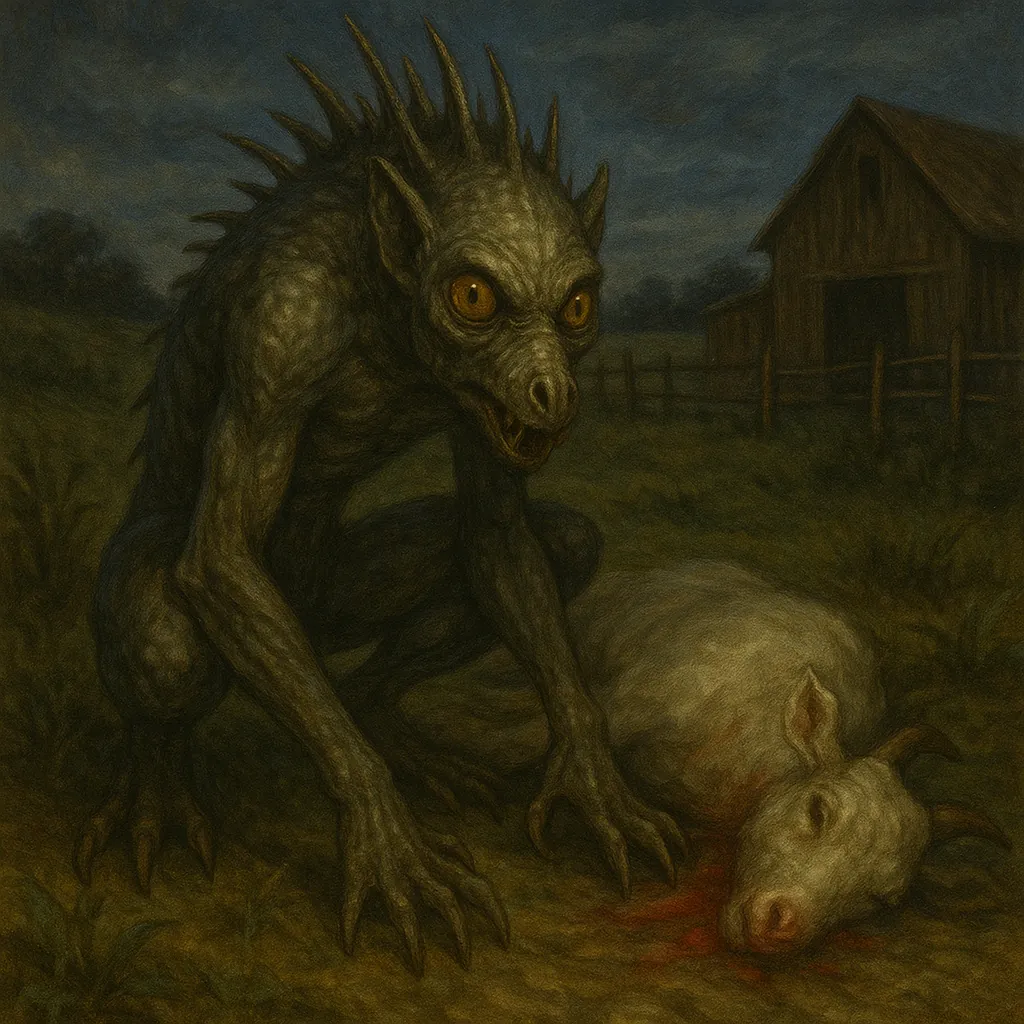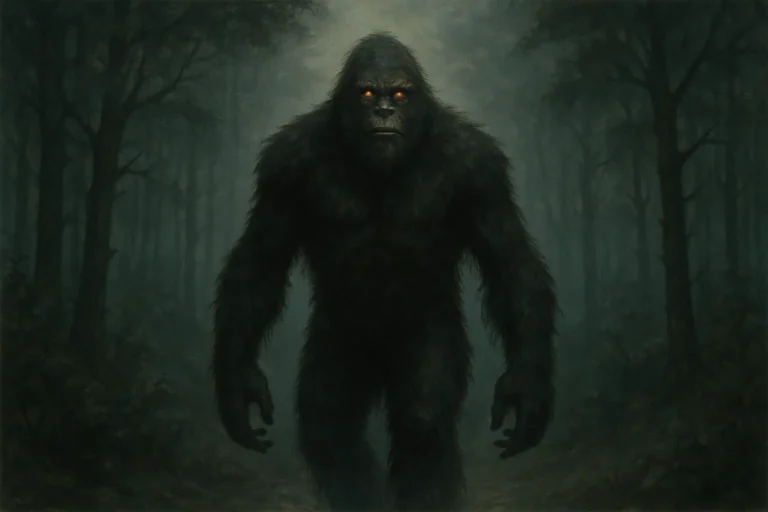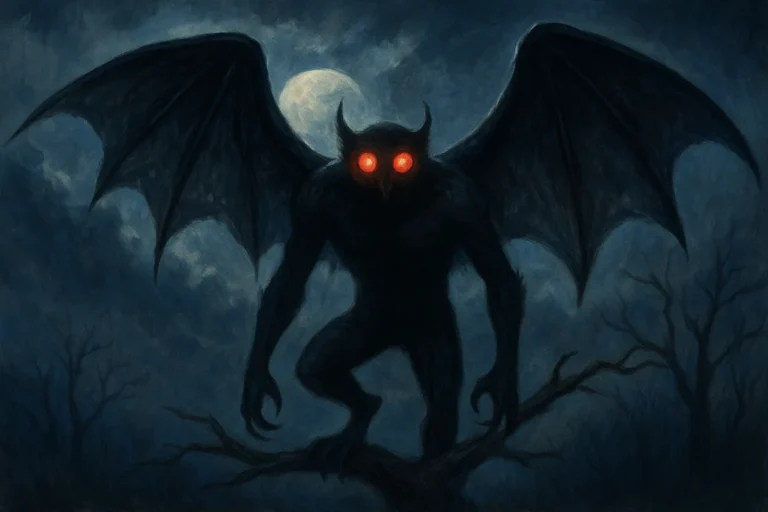Chupacabra: The Blood-Sucking Beast of the Americas

Some say it lurks in the shadows of the countryside, slipping through the night on clawed feet. Others claim it’s more beast than myth — a creature with glowing eyes, sharp fangs, and a thirst for blood. Livestock are found drained, with strange puncture wounds. No tracks. No sign of a struggle. Just fear in the air and a legend whispered across borders.
This is the tale of the Chupacabra, a cryptid whose name literally means “goat sucker.” First reported in Puerto Rico in the 1990s, this creature has become one of the most infamous and hotly debated figures in paranormal lore. But what exactly is it? A vampire-like predator? A misidentified wild animal? Or something else entirely?
Let’s step into the moonlit fields and take a closer look at the mystery that refuses to die.
🐐 Blood in the Barn
The Chupacabra legend burst into public awareness in 1995 when farmers in Puerto Rico began reporting mysterious livestock deaths. Goats, chickens, and even cattle were found with puncture wounds in their necks — and, according to reports, their bodies were completely drained of blood.
The fear spread quickly. Descriptions of the culprit varied, but one of the earliest and most enduring accounts came from a woman named Madelyne Tolentino, who claimed to have seen a bipedal, reptilian creature with large eyes and spikes down its back near the town of Canóvanas. It stood on two legs, looked alien, and seemed almost supernatural.
Within weeks, similar reports emerged from other parts of Puerto Rico — and then from the mainland United States, Mexico, and as far south as Chile. Farmers and ranchers across the Americas were suddenly locking their doors and keeping a wary eye on the night.
👣 Changing Faces of the Beast
Interestingly, the Chupacabra’s appearance seems to shift depending on the region and the time period. In the earliest reports from Puerto Rico, it was described as a scaly, greenish-gray creature with spines running down its back — something almost alien in nature.
But by the 2000s, sightings in the American Southwest and northern Mexico began to describe something quite different: a hairless, dog-like animal with long limbs, pronounced fangs, and leathery skin. This version looked far less like a sci-fi monster and more like a diseased coyote or feral canine.
Some skeptics argued that these newer sightings were simply misidentified animals suffering from mange — a skin disease that causes hair loss and changes in behavior. And in some cases, DNA tests confirmed that supposed “Chupacabra carcasses” were in fact coyotes or raccoons.
Still, believers insisted there was more to the story. After all, mange didn’t explain the bloodless corpses or the eerie precision of the attacks.
🔍 Scientific Theories and Skepticism
From a scientific standpoint, the idea of a creature that exclusively drains blood is hard to support. Blood is not an efficient food source for large animals, and the act of cleanly removing blood without a mess — as is often described in Chupacabra cases — seems biologically implausible.
Benjamin Radford, a prominent investigator of paranormal claims, looked into the phenomenon extensively. In his book Tracking the Chupacabra (2011), he concluded that the legend began with a single misidentified sighting — possibly influenced by the alien creatures featured in the sci-fi horror movie Species, which was released around the same time as the first reports. Radford suggested that fear, media attention, and mass hysteria helped fuel the Chupacabra craze.
But even Radford admitted something interesting: the livestock deaths were real. Animals were dying, and not always in ways easily explained by known predators. While many cases could be attributed to coyotes or wild dogs, a few remained genuinely baffling.
Could there be a rare or unknown predator roaming the Americas?
🌌 Cultural Impact and Urban Legend
Over time, the Chupacabra became more than just a cryptid. It became a cultural icon.
In Latin American folklore, it joined the ranks of La Llorona and El Cucuy as a creature used to caution or scare. News stories, documentaries, books, and even children’s cartoons have featured the “goat sucker.” It has also taken on political and social meaning in some communities — a symbol of external threat or a metaphor for unexplained tragedy.
Its popularity speaks to something deeper: a need to make sense of the unexplained. The Chupacabra is, in many ways, a modern myth — born from fear, shaped by rumor, and kept alive by the human desire to believe in something just beyond our understanding.
🧛 Could There Be Something More?
Even if most sightings can be debunked, the enduring mystery of the Chupacabra lies in the why.
Why do stories of vampiric creatures exist in so many cultures? From the ancient strigoi of Romania to the leeches of Filipino lore, legends of blood-drinking beings go back centuries. Could they all be metaphor — or could there be some grain of truth, lost in the murk of history?
And why, in case after case, do witnesses insist they saw something unnatural? They speak with certainty, often under no public pressure or desire for fame. Their animals are dead. Their fear is real.
Is it mass delusion? Shared cultural imagination? Or the footprints of something still stalking the dark?
🌕 The Legend Lives On
Whether it’s a mange-ridden coyote, a misremembered nightmare, or an undiscovered species, the Chupacabra has carved out a permanent place in paranormal lore. Its name alone stirs the imagination — mysterious, primal, and laced with unease.
Even today, new sightings still crop up now and then. A shadow on a trail camera. A strange carcass found by a riverbed. A bloodless goat in a locked pen.
No conclusive proof has surfaced. But sometimes, mystery is its own kind of truth.
Because in the places where stories live — dusty fields, old barns, and whisper-filled nights — the Chupacabra still prowls.



